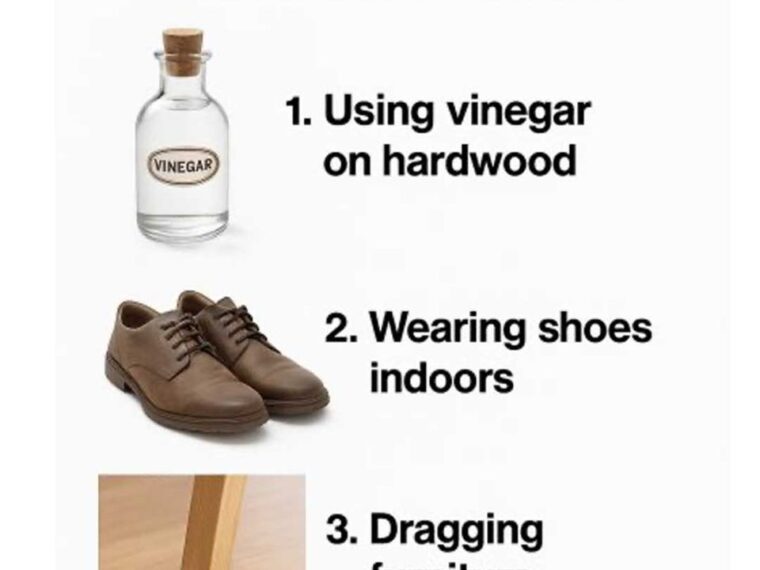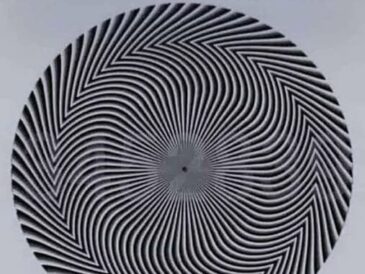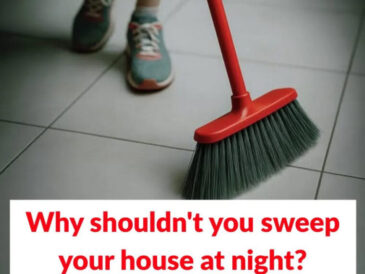Floors are one of the most significant investments in a home, providing both functionality and aesthetic appeal. However, many homeowners unknowingly engage in habits that can prematurely damage their floors, leading to costly repairs or replacements. It is crucial to be aware of these habits to maintain the longevity and beauty of your flooring.
Whether you have hardwood, laminate, tile, or carpet, understanding the specific needs of your flooring material can help you avoid common pitfalls. In this article, we’ll explore ten habits that could be ruining your floors and provide tips on how to prevent unnecessary wear and tear.
1. Using Vinegar on Hardwood Floors
Vinegar is often hailed as a natural cleaning solution, but it can be detrimental to hardwood floors. The acidity in vinegar can strip away the protective finish, leaving the wood vulnerable to damage. Over time, this can cause the wood to become dull and more susceptible to scratches and moisture. Instead, use a pH-balanced cleaner specifically designed for hardwood floors to maintain their shine and protection.
For those who prefer DIY cleaning solutions, consider mixing a few drops of a mild liquid soap with water. Ensure that you use a damp mop rather than a wet one to prevent excess moisture from seeping into the wood.
2. Wearing Shoes Indoors
Wearing shoes indoors can track dirt, grit, and other abrasive particles onto your floors, acting like sandpaper and scratching the surface. High heels, in particular, can cause dents and damage due to the concentrated pressure they exert on small areas of the floor. To protect your floors, consider implementing a no-shoe policy in your home and provide slippers or indoor shoes for guests.
Regularly sweeping or vacuuming can help remove any particles that make their way inside, further protecting your floors from unnecessary wear.
3. Dragging Furniture Across the Floor
Dragging furniture across the floor can cause deep scratches and gouges, especially on hardwood, laminate, and even tile surfaces. These scratches not only mar the appearance of your floors but can also compromise their structural integrity over time. To prevent this, always lift furniture when moving it or use furniture sliders, which reduce friction and protect the floor surface.
Another tip is to place felt pads under the legs of furniture pieces. This not only makes movement easier but also prevents scratches caused by subtle shifts during everyday use.
4. Using Steam Mops on Laminate Flooring
Steam mops are popular for their ability to sanitize and clean floors without chemicals, but they can be harmful to laminate flooring. The excessive moisture and heat can cause the laminate to warp, swell, or peel. Laminate floors are not designed to withstand high levels of moisture, and the steam can seep into the seams, causing irreversible damage.
To clean laminate floors, opt for a slightly damp mop or a microfiber cloth. Ensure that the mop is wrung out thoroughly to avoid any water pooling on the surface, and always follow up with a dry cloth to remove any excess moisture.
5. Ignoring Spills and Stains
Ignoring spills and stains can lead to permanent damage, especially on porous surfaces like wood and carpet. Liquids can penetrate the protective finish on hardwood, causing discoloration, while carpets can absorb stains, making them difficult to remove if not addressed promptly. Always clean up spills immediately using a soft cloth or paper towel.
For stubborn stains, use a cleaner appropriate for your floor type and always test in an inconspicuous area first. Prompt attention to spills not only prevents damage but also helps maintain a hygienic living environment.
6. Using the Wrong Cleaning Products
Using the wrong cleaning products can irreparably damage your floors. For instance, oil-based soaps on hardwood can leave residues that dull the finish, while bleach can discolor and weaken carpet fibers. Each flooring material has specific cleaning needs, so it’s vital to use products designed for your particular floor type.
When in doubt, consult the manufacturer’s guidelines for recommended cleaning products, or opt for pH-neutral solutions that are generally safe for most floor types. Regular maintenance with the right products will keep your floors looking their best.
7. Over-Waxing Wooden Floors
Over-waxing can lead to a build-up of residue, making floors look dull and dirty despite regular cleaning. It can also create a slippery surface, increasing the risk of falls. Most modern hardwood floors have a polyurethane finish that doesn’t require waxing. Adding wax on top of this finish can lead to a messy build-up.
If your floors do need waxing, limit it to once or twice a year, and always follow the manufacturer’s instructions. Regular sweeping and using a damp mop can keep your floors clean without the need for frequent waxing.
8. Skipping Regular Maintenance
Skipping regular maintenance can lead to a gradual decline in the condition of your floors. Dirt and debris can accumulate, causing scratches and wear, while neglected floors can develop more serious issues over time. Routine cleaning and periodic deep cleaning are essential to maintain the longevity of your flooring.
Create a cleaning schedule that includes sweeping or vacuuming at least once a week, and mopping or steaming (with caution) as needed. Regularly inspect your floors for signs of damage and address issues promptly to prevent them from worsening.
9. Neglecting to Use Rugs and Mats
Rugs and mats are essential for protecting high-traffic areas from wear and tear. They help trap dirt and moisture, preventing them from reaching the floor. Place mats at entryways to catch dirt from shoes, and use rugs in areas where spills are likely, such as under dining tables and in kitchens.
Ensure that the rugs and mats have a non-slip backing to prevent accidents, and clean them regularly to avoid buildup that could damage the floor underneath. By strategically placing rugs and mats, you can significantly extend the life of your flooring.
10. Allowing Pets to Scratch Surfaces
Pets, especially dogs and cats, can scratch flooring surfaces with their claws. These scratches are not only unsightly but can also penetrate the finish and expose the floor to further damage. Regularly trimming your pet’s nails is a simple and effective way to minimize scratching.
Additionally, providing pets with designated play areas and using rugs or mats in their favorite spots can help protect your floors. Consider using pet-friendly furniture covers and floor protectors to keep your floors looking their best while accommodating your furry friends.
11. Overlooking Humidity and Temperature Control
Humidity and temperature fluctuations can cause floors, particularly hardwood, to expand and contract, leading to warping, gaps, and other forms of damage. Maintaining a consistent indoor climate is crucial for preserving the integrity of your floors.
Use a humidifier during dry months and a dehumidifier during humid months to keep the indoor humidity level between 30-50%. Additionally, avoid placing flooring near heat sources or direct sunlight, which can cause fading and temperature-related damage. By controlling the environment, you can ensure that your floors remain stable and beautiful for years to come.




